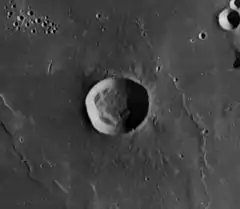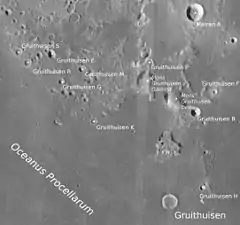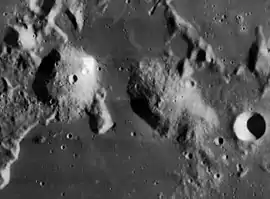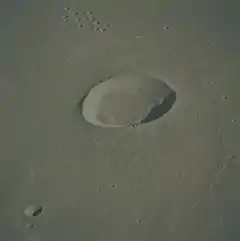Gruithuisen (crater)
Gruithuisen is a lunar impact crater that lies on the section of lunar mare that joins Oceanus Procellarum in the west to Mare Imbrium in the east. Southeast of Gruithuisen is the small crater Delisle. To the south is Dorsum Bucher, a wrinkle ridge running in a north–south direction for about 90 kilometers.
 Lunar Orbiter 4 image | |
| Coordinates | 32.9°N 39.7°W |
|---|---|
| Diameter | 16 km |
| Depth | 1.9 km |
| Colongitude | 40° at sunrise |
| Eponym | Franz von Gruithuisen |

The rim of Gruithuisen is relatively smooth and circular, projecting only slightly above the surrounding mare. The interior is relatively featureless with a small floor, with mounds of material deposited along the edges of the sloping inner walls.

To the north of the crater, along the edge of the highland peninsula between the two maria is a domed mountainous rise that is designated Mons Gruithuisen Gamma (γ). Just to the east of this feature is another mountainous rise named Mons Gruithuisen Delta (δ). Northwest of Gruithuisen crater is concentrated cluster of several craterlets, which was most likely formed from a single body that broke up just prior to impact.
Satellite craters
By convention these features are identified on lunar maps by placing the letter on the side of the crater midpoint that is closest to Gruithuisen.
| Gruithuisen | Latitude | Longitude | Diameter |
|---|---|---|---|
| B | 35.6° N | 38.8° W | 9 km |
| E | 37.3° N | 44.3° W | 8 km |
| F | 36.3° N | 37.9° W | 4 km |
| G | 36.6° N | 43.9° W | 6 km |
| H | 33.3° N | 38.4° W | 6 km |
| K | 35.3° N | 42.7° W | 6 km |
| M | 36.9° N | 43.2° W | 7 km |
| P | 37.1° N | 40.5° W | 11 km |
| R | 37.1° N | 45.3° W | 7 km |
| S | 37.5° N | 45.6° W | 7 km |
References
- Andersson, L. E.; Whitaker, E. A. (1982). NASA Catalogue of Lunar Nomenclature. NASA RP-1097.CS1 maint: ref=harv (link)
- Blue, Jennifer (July 25, 2007). "Gazetteer of Planetary Nomenclature". USGS. Retrieved 2007-08-05.CS1 maint: ref=harv (link)
- Bussey, B.; Spudis, P. (2004). The Clementine Atlas of the Moon. New York: Cambridge University Press. ISBN 978-0-521-81528-4.CS1 maint: ref=harv (link)
- Cocks, Elijah E.; Cocks, Josiah C. (1995). Who's Who on the Moon: A Biographical Dictionary of Lunar Nomenclature. Tudor Publishers. ISBN 978-0-936389-27-1.CS1 maint: ref=harv (link)
- McDowell, Jonathan (July 15, 2007). "Lunar Nomenclature". Jonathan's Space Report. Retrieved 2007-10-24.CS1 maint: ref=harv (link)
- Menzel, D. H.; Minnaert, M.; Levin, B.; Dollfus, A.; Bell, B. (1971). "Report on Lunar Nomenclature by the Working Group of Commission 17 of the IAU". Space Science Reviews. 12 (2): 136–186. Bibcode:1971SSRv...12..136M. doi:10.1007/BF00171763.CS1 maint: ref=harv (link)
- Moore, Patrick (2001). On the Moon. Sterling Publishing Co. ISBN 978-0-304-35469-6.CS1 maint: ref=harv (link)
- Price, Fred W. (1988). The Moon Observer's Handbook. Cambridge University Press. ISBN 978-0-521-33500-3.CS1 maint: ref=harv (link)
- Rükl, Antonín (1990). Atlas of the Moon. Kalmbach Books. ISBN 978-0-913135-17-4.CS1 maint: ref=harv (link)
- Webb, Rev. T. W. (1962). Celestial Objects for Common Telescopes (6th revised ed.). Dover. ISBN 978-0-486-20917-3.CS1 maint: ref=harv (link)
- Whitaker, Ewen A. (1999). Mapping and Naming the Moon. Cambridge University Press. ISBN 978-0-521-62248-6.CS1 maint: ref=harv (link)
- Wlasuk, Peter T. (2000). Observing the Moon. Springer. ISBN 978-1-85233-193-1.CS1 maint: ref=harv (link)
